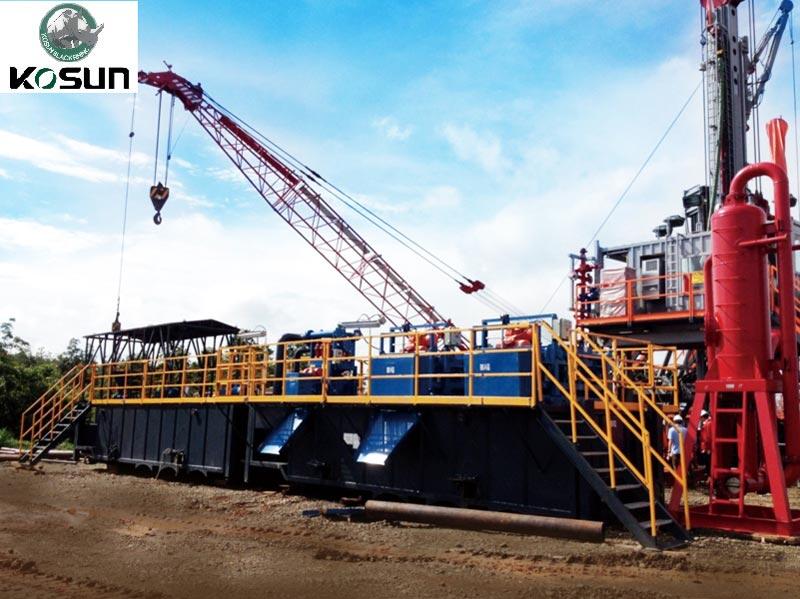- Home
- Products
-
-
Solids Control Equipment
- Linear Motion Shale Shaker
- Decanter Centrifuge
- Mud Cleaner
- Vacuum Degasser
- Centrifugal Pump
- Shear Pump
- Submersible Slurry Pump
- Mud Agitator
- Mud Gun
- Jet Mud Mixer
- Desilter
- Water Tank
- LS606 Shale Shaker
- Mud Tank
- LS1850 Shale Shaker
- Diesel Tank
- Dome-shaped mud cleaner
- Vertical cyclone desilter
- KQG30 Automatic Tank Cleaning
- MD210 Drilling Mud Cleaner
-
Solids Control System
- Solids Control System
- Mobile Solids Control System
- Arctic Solids Control System
- Drilling Mud Cooling System
- Liquid Mud Plant (LMP )
-
TBM
- Tunnel Boring Mud System
-
HDD
- HDD Mud Recovery System
-
-
- News
- Services
- Marketing
- About Us
- Contact Us
- Videos
Home > KOSUN News >
Drilling Mud Zero-discharge Treatment Process
Jun 24, 2019
Drilling waste mud is one of the primary pollution sources in the oil and gas industry. Due to engineering requirements, oil drilling mud is mixed with oil, water, organic clay and other materials. In the past two years, the drilling crew has been using more and more oil-based mud, water-based mud and composite-based mud, and the increase in cost and environmental pollution problems have become rather serious.
The emergence of the mud zero-discharge treatment system successfully solved the problem that the drilling waste cannot be treated efficiently and environmentally. The main treatment process of the mud zero-discharge treatment system means that the drilling waste returned from the wellhead will be treated harmlessly while drilling before it falls to the ground. The waste mud in the waste mud pit can also be diluted and then classified and utilized. The mud that has been effectively and harmlessly treated can be reused repeatedly, and the frictional resistance is effectively reduced, the accident rate is lowered, and the well quality is improved.

Different from the traditional way, the mud zero-discharge system changes the waste mud from “end treatment” to “full process control”, and the waste mud is diluted- flocculated- separated into three parts: cuttings, mud cake and water. The solid matter in mud is treated through water washing, flocculation separation and chemical reaction, so that the cuttings and mud cake reach the discharge standard, the harmful substances in mud and the chloride ions are precipitated into the water, and then dehydrated by vacuum adsorption or extrusion to form mud cake. At the same time, the centrifugally separated wastewater is concentrated through air flotation sedimentation, filtration system and reverse osmosis system, and the treated wastewater is up to standard and can be recycled for well drilling.
Wastes, such as cuttings, separated from drilling waste can be reused as concrete base after a series of purification, drying and recovery; the mud water generated by cleaning the cuttings is dosed, destabilized, flocculated and separated to form mud cake, which can be blended with clay or shale to burn bricks. Through pretreatment processes such as destabilization, flocculation, air flotation, oxidation and adsorption filtration to remove major pollutants, the separated filtrate water can be used for oilfield reinjection, safe formation reinjection or up-to-standard discharge; after being treated by the sewage treatment system, the sewage can reach the standard of discharge.
The emergence of the mud zero-discharge treatment system successfully solved the problem that the drilling waste cannot be treated efficiently and environmentally. The main treatment process of the mud zero-discharge treatment system means that the drilling waste returned from the wellhead will be treated harmlessly while drilling before it falls to the ground. The waste mud in the waste mud pit can also be diluted and then classified and utilized. The mud that has been effectively and harmlessly treated can be reused repeatedly, and the frictional resistance is effectively reduced, the accident rate is lowered, and the well quality is improved.

Different from the traditional way, the mud zero-discharge system changes the waste mud from “end treatment” to “full process control”, and the waste mud is diluted- flocculated- separated into three parts: cuttings, mud cake and water. The solid matter in mud is treated through water washing, flocculation separation and chemical reaction, so that the cuttings and mud cake reach the discharge standard, the harmful substances in mud and the chloride ions are precipitated into the water, and then dehydrated by vacuum adsorption or extrusion to form mud cake. At the same time, the centrifugally separated wastewater is concentrated through air flotation sedimentation, filtration system and reverse osmosis system, and the treated wastewater is up to standard and can be recycled for well drilling.
Wastes, such as cuttings, separated from drilling waste can be reused as concrete base after a series of purification, drying and recovery; the mud water generated by cleaning the cuttings is dosed, destabilized, flocculated and separated to form mud cake, which can be blended with clay or shale to burn bricks. Through pretreatment processes such as destabilization, flocculation, air flotation, oxidation and adsorption filtration to remove major pollutants, the separated filtrate water can be used for oilfield reinjection, safe formation reinjection or up-to-standard discharge; after being treated by the sewage treatment system, the sewage can reach the standard of discharge.


